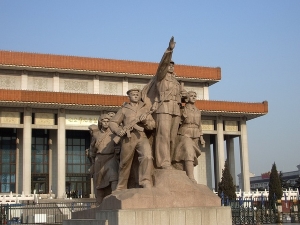China’s Use of Armed Coercion

Speaker: Mr. James Siebens (Stimson Center)
Date: 5 December 2023
Speaker Session Summary
China has become a regional power in the Asia-Pacific with minimal use of its armed forces. However, the buildup of its armed forces was still an important factor in China’s ascension to great power status. Mr. Siebens’ presentation was based on his new book, “China’s Use of Armed Coercion: To Win Without Fighting,” which is a sequel to books examining the United States’ and Soviet Union’s buildup of military power for deterrence purposes. Mr. Siebens emphasized that avoiding a hot war is the most important job of the US military, along with giving allies confidence and US politicians diplomatic strength. Like the US, China uses its military as a political signaling tool—especially when it comes to deterrence.
China views deterrence, or weishe, as “an active response that targets the psychological, cognitive, and decision-making systems of the opponent, and its effect is to make the adversary aware, on the balance of probabilities, that taking a certain action will cost them more than they can afford and gain.” Several approaches China takes to deterrence are direct deterrence, rollback deterrence, and coercion. Several examples of how China used its armed forces were described; however, most of the examples focused on China using direct deterrence to bully smaller neighbors over sovereignty disputes. These examples include China using ship patrols around the Second Thomas Shoal to intimidate the Philippines and a buildup of its military along the Sino-Indian border. Mr. Siebens also described the effectiveness of China’s actions. He demonstrated that China’s direct use of military force as a deterrent was the most effective, while more politically coercive actions tended to backfire on China because of political backlash. Mr. Siebens gave several suggestions on how to react to China’s deterrence, emphasizing that it almost always backs down from a scenario that could result in military confrontation.
Speaker Session Recording
This session was not recorded, please reach out to Mariah Yager (Mariah.c.yager.ctr@mail.mil) for additional presentations by Mr. Siebens on this topic.
Briefing Materials
Recommended reading:
Biography: James A. Siebens is a Fellow with the Stimson Center’s Reimagining U.S. Grand Strategy program. He is the editor of China’s Use of Armed Coercion: To Win Without Fighting (Routledge, forthcoming), a study on China’s use of military and paramilitary forces for purposes of coercion. He is also an editor of Military Coercion and U.S. Foreign Policy: The Use of Force Short of War (Routledge 2020), a book on U.S. strategy and military operations since the end of the Cold War. Siebens’ research focuses on grand strategy, military coercion, and gray zone conflict. He previously served as a Research Associate and Special Assistant to the President and CEO at the Stimson Center. Prior to joining Stimson, Siebens was a Data Analyst at the National Consortium for the Study of Terrorism and Responses to Terrorism (START) at the University of Maryland, where he contributed to a DoD-sponsored study on gray zone conflict. Siebens is a Term Member at the Council on Foreign Relations, and holds an M.A. in International Affairs with a concentration in Global Security from American University’s School of International Service.
Comments